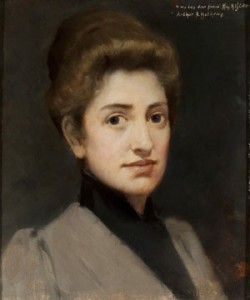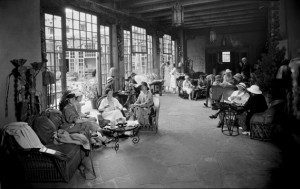Noted Southwestern author Frank Waters once referred to Mary Colter as having “a tender heart and a caustic tongue.” She could write the sweetest notes to the child of her onetime mentee, and scathing ones to architect John Gaw Meem, with whom she worked on La Fonda. (In one of the notes, she asked him precisely where he thought he might end up when he died.)
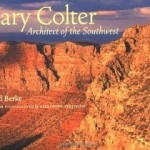 Those were among the tidbits of a grand life shared this morning by Arnold Berke, the biographer of Mary Colter (Mary Colter: Architect of the Southwest) at this morning’s continuation of A Mary Colter Weekend. During his research, he found few blueprints, which aren’t built for survival to begin with; few original documents revealing anything of her love life (if any); and, as the years pass, fewer and fewer examples of her iconic architecture and designer’s eye.
Those were among the tidbits of a grand life shared this morning by Arnold Berke, the biographer of Mary Colter (Mary Colter: Architect of the Southwest) at this morning’s continuation of A Mary Colter Weekend. During his research, he found few blueprints, which aren’t built for survival to begin with; few original documents revealing anything of her love life (if any); and, as the years pass, fewer and fewer examples of her iconic architecture and designer’s eye.
Those were signs, he said, of a woman who was not appreciated in her own time, nor after her own time. That’s all the more sad when you consider she was alive at the same time as Frank Lloyd Wright and Julia Morgan, William Randolph Heart’s architect. (And no, Berke said, he found no evidence that Colter ever met either of them. And yes, he’s asked that question every time he speaks.)
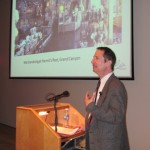 Only in recent years, Berke said, has interest in Colter risen, particularly among Grand Canyon aficionados. Colter’s buildings along the South Rim and Phantom Ranch at the canyon’s bottom pioneered a style of architecture now used by most national and state parks. It’s called National Park Service Rustic, and Colter was, Berke said, “truly a pioneer of this idiom.”
Only in recent years, Berke said, has interest in Colter risen, particularly among Grand Canyon aficionados. Colter’s buildings along the South Rim and Phantom Ranch at the canyon’s bottom pioneered a style of architecture now used by most national and state parks. It’s called National Park Service Rustic, and Colter was, Berke said, “truly a pioneer of this idiom.”
A master builder as well designer, Colter married rock, tile, timber, glass, and wrought iron, employed a keen eye for talent in hiring artists like a young Fred Kabotie, and brewed up buildings that grew out of rock ledges, or simply appeared on a forest floor, complete and natural, as if they had always been there. Take a gander at two strikingly different models. The Pueblo-meets-Spanish style of La Fonda on the Plaza’s softly stuccoed and stacked curves (Philosopher Simone de Beauvoir once called La Fonda”The most beautiful hotel in America, perhaps the most beautiful hotel I’ve seen in my life.”):
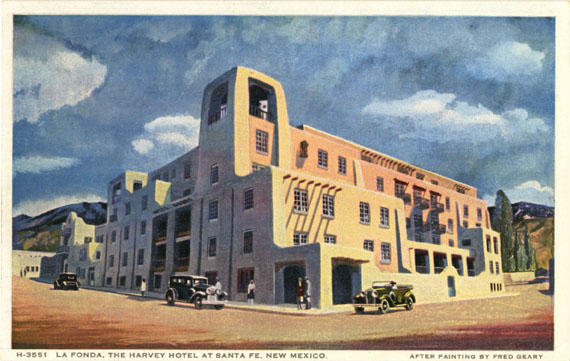
La Fonda, Santa fe
And the seemingly haphazard collection of rocks that make up the very stable Hermit’s Rest at the Grand Canyon:

Nothing about Colter’s designs was haphazard, Berke said. First-time visitors to her buildings would appreciate seemingly antique furniture that craftsmen had just built, along with soot marking the walls above brand-new fireplaces. “You can’t imagine how difficult it was to make that look old,” she once said.
She designed the interiors of Kansas City’s, Chicago’s and Los Angeles’ Union Stations and created the Mimbres-influenced dishes once used on the Santa Fe Railway and now sold for hundreds of dollars per teacup. She did so at a time when women were not architects, or if they were, they didn’t climb rock monuments to study their composition. Berke said her success was likely due to a combination of nature and nurture — a naturally strong-willed person with an artistic bent, she was raised in the heartland of America at a time when “going West” was the place to go.
By the time she died in 1958, Colter had seen her time come and go. El Ortiz in Lamy, NM, was torn down in 1943. El Navajo in Gallup was destroyed in 1957, along with the monumental sand paintings Colter had persuaded Navajo artisans to create. She outlived Albuquerque’s Alvarado, but only barely. Torn down in 1970, it’s still mourned by lovers of architecture.
The resurgence of interest in her inspired Berke to propose what some might consider a fool’s quest. He referenced the exquisite collection of Native jewelry she had amassed and eventually bequeathed to Mesa Verde Museum, where most of it, like most museum collections, is in storage. Maybe, he said, some enterprising museum type could work out a loan and put the jewelry on exhibit?
To the hearty applause of Berke’s audience, New Mexico History Museum Director Fran Levine said that, yes, she would be that person.

